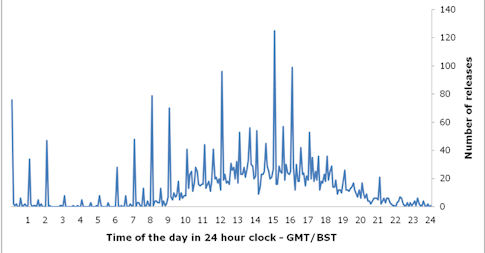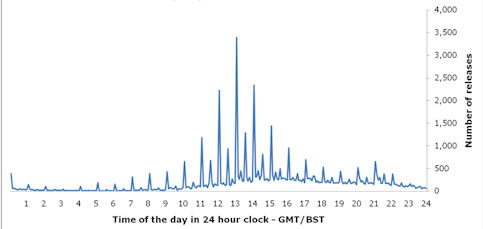When are the most popular times to send out a press release? When will you be competing the most for attention? To find the answers to these and other press release distribution timing questions, press release distribution company RealWire analysed over 50,000 press releases indexed by its PRFilter application in March 2011.
A key finding from this research showed that one quarter of all releases analysed were timed to go out exactly on the hour. And the most popular time of day is 1.00pm, with six per cent of all releases going out at this time. For those releases originating in the UK, 4.00pm is the most popular time, with two per cent of UK releases going out at this time.
The timing of UK press release distribution

Other findings included:
31 times more releases (24 times for the UK) were timed on the hour than for the least popular individual minute within the hour.
50 per cent of all releases analysed and 48 per cent of UK originating releases were timed between 12 noon and 5.00pm.
Does this mean that on the hour is the worst time to send a release? Adam Parker, chief executive of RealWire says that this depends, as some markets offer little flexibility: “The large amount of activity observed around the hour mark makes these times potentially ones where a press release will have a lot of competition for attention. In the case of investor-related announcements there may be little flexibility over timing and also the need to co-ordinate the exact moment when announcements are made.”
The timing of global press release distribution

However, Parker says that if you don’t have to stick to a time, it makes sense to choose a period when you face less competition: “PROs should perhaps consider avoiding the more obvious timings and look at distribution at times of lower concentration. This could be beneficial to pick up as your release is arguably more likely to be read – assuming it is relevant of course – if it is one of few and not one of many.”
Parker points out that a large majority of the overall sample originated in the US or Canada. The high concentration of releases between noon and 5.00pm UK time (50 per cent) reflects the fact that a high proportion of these North American releases are distributed in the morning local time. Parker adds: “It is interesting to note that there is a similar pattern of concentration with UK originating releases with almost the same proportion (48 per cent) being timed between noon and 5.00pm UK time. This contrasts with a much lower proportion (23 per cent) timed between 7.00am and noon.
“This suggests that potentially UK PROs are holding back announcements until later in the day which may be due to waiting until the US media is awake. This may be beneficial for announcements with a strong US focus, but PROs should consider whether there could be benefits to targeting relevant UK publications with their announcements in the morning when there is less activity.”
Methodology
RealWire analysed a sample of 54,160 press releases indexed by PRFilter throughout March 2011. Of these a separate sample of 3,750 press releases that were identified as originating from the UK were also analysed.
Based on the release time the press releases were grouped into one minute intervals across the month of March. Releases sent in the same minute of the day, for example 1.00pm to 1.01pm each day, were summed for all days in the month.
The number of releases was also summed based on the particular minute within an hour they were timed at. For example releases timed in the first minute of each hour – midnight to one minute past, 1.00am to 1.01am, 2.00am to 2.01am, etc, were summed for all hours and all days in the month.
PR Masterclass: The Intersection of PR and GEO
Join PRmoment for a Masterclass featuring 10 of the industry’s foremost experts. You will walk away with a clear, actionable strategy for adapting your content to an AI-first search environment.
Taking place on Wednesday 25th February in London, both virtual and in person tickets are available.
Early bird ticket sale ends Friday 9 January.
PR MasterclassIf you enjoyed this article, sign up for free to our twice weekly editorial alert.
We have six email alerts in total - covering ESG, internal comms, PR jobs and events. Enter your email address below to find out more:









